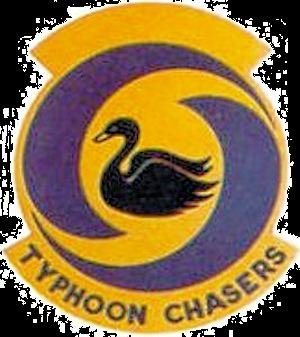Active 1944-1987 Type Weather Reconnaissance | ||
 | ||
Branch | ||
The 54th Weather Reconnaissance Squadron is an inactive United States Air Force unit. Its last assignment was to the 41st Rescue and Weather Reconnaissance Wing, stationed at Andersen Air Force Base, Guam.
Contents
It was inactivated on 30 September 1987.
History
Established in mid-1944 in England as a weather reconnaissance squadron; it was assigned to the Eighth Air Force. The squadron's primary mission was acquiring accurate weather information over enemy-occupied Continental Europe, including Nazi Germany for mission planning of heavy bombardment missions to identified enemy industrial, transportation and military targets. It flew a wide variety of medium bombers and fighter aircraft, all at high speed and unarmed over enemy-held territory on a daily basis. These missions were highly hazardous and usually flown without any escort. The squadron continued operations until the German capitulation in May 1945, when it returned to the United States.
Redeployed to North Field, Guam and issued very long range B-29 Superfortress bombers, it was fitted-out with weather reconnaissance equipment in September 1945. The unit flew weather reconnaissance missions for the Far East Air Forces during the early postwar years, inactivating in October 1947.
It was reactivated in 1951 at North Field (later Andersen AFB), Guam. The squadron resumed its weather reconnaissance mission with WB-29s; upgrading to WB-50D Superfortresses in 1955. It often flew hazardous reconnaissance missions into tropical storms and typhoons to obtain accurate meteorological information. It was inactivated in 1960 due to budget reductions.
The squadron was reactivated in 1960 with a mixture of WB-50s, WB-47s and C-130s and resumed its typhoon hunting mission. The squadron was the last operator of the WB-50D Superfortress, retiring the last aircraft in 1965, when it operated C-130s.
Perhaps its best accomplishment was during the Vietnam War when Operation Popeye (Project Popeye/Motorpool/Intermediary-Compatriot) was a US military cloud seeding operation (running from March 20, 1967 until July 5, 1972) to extend the monsoon season over Laos, specifically areas of the Ho Chi Minh Trail. Operating WC-130A aircraft flying out of Udorn, Thailand, the operation seeded clouds with silver iodide, resulting in the targeted areas seeing an extension of the monsoon period an average of 30 to 45 days. As the continuous rainfall slowed down the truck traffic, it was considered relatively successful. The 54th Weather Reconnaissance Squadron carried out the operation to "make mud, not war."
In 1974, a newly converted WC-130 (serial number 65-0965) was sent to investigate Typhoon Bess. The crew departed Clark Air Base in the Philippines with the callsign Swan 38. Radio contact with the aircraft was lost on 12 October 1974, apparently as the aircraft was heading into the typhoon's eye to make a second position fix. There were no radio transmissions indicating an emergency on board, and search teams could not locate the aircraft or its crew. All six crew members were listed as killed in action.
It was inactivated in 1987, along with its associated weather unit, Detachment 3, 1st Weather Wing. The aircraft were dispersed to the remaining weather reconnaissance squadrons, the 53rd WRS and the Air Force Reserve unit, the 815th WRS, both at Keesler AFB, Mississippi.
